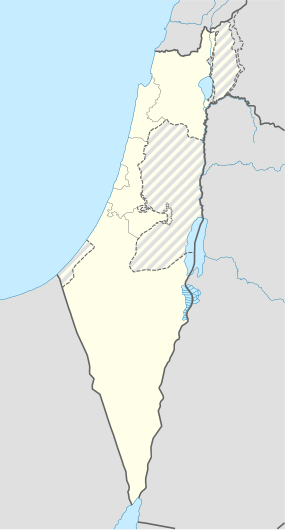Huqoq
| חקק | |
 |
|
| Alternate name | Hukkok |
|---|---|
| Location | Galilee, Israel |
| Region | Levant |
| Coordinates | 32°53′5″N 35°28′44″E / 32.88472°N 35.47889°ECoordinates: 32°53′5″N 35°28′44″E / 32.88472°N 35.47889°E |
| Part of | Kingdom of Israel |
| History | |
| Periods | Early Bronze Age - Byzantine period |
| Site notes | |
| Excavation dates | 2011 |
| Archaeologists | Shua Kisilevitz |
Huqoq or Hukkok (Hebrew: חוקוק) was an ancient Jewish village, located 12.5 km north of Tiberias. The area had been settled since ancient times and is mentioned in the Book of Joshua. The Arab village Yaquq was built at Huqoq's location, and a kibbutz named Hukok was established near the site on 11 July 1945.
The village site was inhabited in the Early and Middle Bronze Age. The Canaanites called it Hukkok, and during the Roman period it was known as Hucuca.
Hukkok (Hebrew חקק) is mentioned in the Bible in Josh. 19.34. Archaeological investigations at the site of the former village of Yaquq, located near the Sea of Galilee, 12.5 km north of Tiberias, uphill from Capernaum and Magdala, suggest that it was inhabited in the Iron Age, Persian, Hellenistic, Roman, Byzantine, Abbasid, Fatimid, Mamluk and Ottoman periods.
The Roman period village was large and prosperous due to the presence of a constant spring. Archaeologist Jodi Magness told Science News that the "high artistic quality and the tiny size of the mosaic cubes,... together with the monumental size of the stones used to construct the synagogue’s walls, suggest a high level of prosperity in this village, as the building clearly was very costly.” The prosperity of the ancient village contrasts with the simplicity of the Ottoman era settlement and can be seen by archaeologists in animal bones which were cut by professional butchers in the ancient Jewish village, and by farmers in the Muslim period. It is apparent from both the synagogue and the absence of pork bones that the Roman period village was Jewish.
"The ancient village is surrounded by associated features, including cist graves, rock-cut tombs, a mausoleum, quarries, agricultural terraces and installations, a winepress and an olive press. Two large miqwa’ot (ritual baths) are hewn into bedrock on the eastern and southern periphery of the ancient village (see below)."
The village is attested in Late Roman and Byzantine period rabbinic sources.
...
Wikipedia

